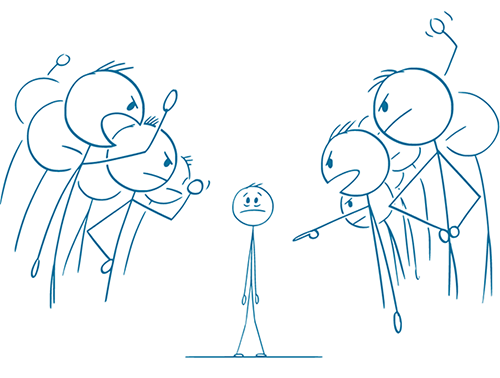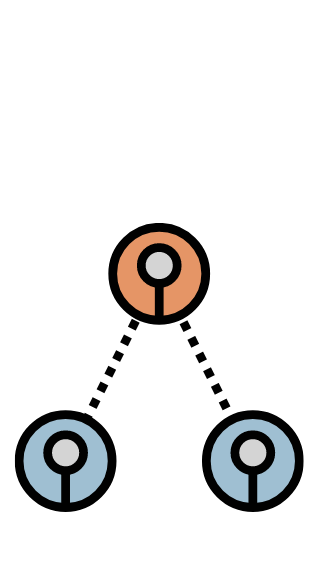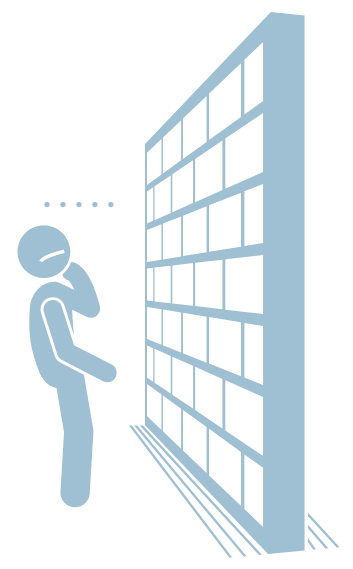From Blame to Empowerment — Healing as the Family Scapegoat

Scapegoating is a specific form of abuse that occurs in society on every level, including the family. In unhealthy or dysfunctional family systems, there is often a tendency to evade confronting issues and emotions. Consequently, one family member often becomes the scapegoat, bearing the blame for the family’s problems.
The following will delve into why certain children are chosen as the scapegoat, the impact of being scapegoated, and the paths to healing and recovering from such abuse.
What characterizes a dysfunctional family?
Every family faces its own set of challenges and issues, and no family is without flaws. However, the way these problems are handled—or whether they are addressed at all—can have long-lasting effects on family members, often for the duration of their lives.
One hallmark of a dysfunctional family is the imposition of strict and inflexible rules. Some of these include:
Don't ask questions.
Don't feel your feelings.
Don't challenge the norm.
These severe and unhealthy family directives can lead to a lack of emotional support or to the dismissal of important emotional needs in vulnerable members.
Other common behavioral patterns include triangulation, gaslighting, and stonewalling.

Triangulation
Refers to a communication pattern where one person avoids direct interaction with another, instead using a third person as an intermediary. This can create misunderstandings and conflicts, often serving as a manipulative strategy to control or gain power.

Gaslighting
A form of psychological abuse in which a person causes someone else to question their own sanity, memories, and reality.

Stonewalling
Completely shutting down when there is a disagreement or a conversation that one person does not want to complete or is using as a form of punishment towards the other person. Stonewalling is different from taking a time out or a break/breath; it is instead someone leaving another person or just shutting out the other person with no want or means to communicate again about whatever matter it is that someone is shutting down. Stonewalling can lead to feelings of abandonment and attachment difficulties.
What roles do we see within dysfunctional family dynamics?
EMOTIONALLY IMMATURE PARENT (EIP)
Everyone operates around meeting the Emotionally Immature Parent's needs. This parent might struggle with substance abuse, mental health issues, or exhibit abusive behavior.
ENABLER
The Enabler protects and takes care of the EIP so that the EIP is never allowed to experience the negative consequences of their actions. Often the Enabler is the spouse of the EIP, but the role could also be assigned to one of the children.
GOLDEN CHILD / HERO
The Golden Child or Hero is tasked with making the family look well-adjusted or normal on the surface. This child may be favorited and can do no wrong.
MASCOT
The Mascot diffuses conflict in the family. They are the joker of the family, providing comedy relief and other methods of deflection to mask the dysfunction of the family.
LOST CHILD
The Lost Child's role is to keep their head down and act as if nothing of significance is going wrong.
SCAPEGOAT
The Scapegoat is chosen to carry the toxic feelings and emotions of the parent. It is a way to distract from or take responsibility for their own problems and behaviors.
What traits make the family scapegoat a target within the family system?
Family scapegoats often possess characteristics that make them susceptible to being targeted within the family system. Because these individuals exhibit traits such as sensitivity, vulnerability, or nonconformity, they may be more likely to rock the boat, in comparison to other family members who uphold the dysfunctional status quo. Additionally, scapegoats may be more likely to challenge unhealthy patterns within the family or speak out against injustice, further alienating them from others. As a result, they are often unfairly blamed for problems within the family unit, serving as a distraction from addressing deeper issues. Some arbitrary reasons one might be chosen are:
- Birth order
- Gender
- Appearance
- Biological relations versus Step versus Adopted
- Intellect
- Mental health
- Physical health
- Sexual orientation
- Personality traits
All these factors can play a role in designating a scapegoat in a dysfunctional family, and none of these factors are under anyone’s control.
What are the effects of being the family scapegoat?
The presence of a scapegoat in a family dynamic can have several negative consequences. Firstly, it creates an imbalance of power, unfairly burdening one individual with blame and shame while allowing others to avoid accountability. This can lead to feelings of resentment and isolation for the scapegoat and perpetuate cycles of dysfunction within the family. This imbalanced power dynamic can lead to feelings of inadequacy, low self-esteem, and even depression or anxiety. The scapegoat may internalize the negative perceptions projected onto them, leading to a distorted sense of self-worth. They may believe they really are the problem, and they may feel lonely, unsupported, and unworthy. Internalizing negative beliefs about themselves, can lead to self-sabotage, neglecting their needs, engaging in reckless behavior, or even self-harm.
Furthermore, being cast as the family scapegoat can result in long-term effects that impact relationships outside of the family unit. Individuals who have experienced this role may struggle with trust issues, intimacy problems, and difficulty forming healthy connections with others. Dysfunctional behavior may become normalized due to their upbringing, making it challenging for them to recognize such patterns. Additionally, they may not believe they deserve better, leading them to accept less in platonic, work, and romantic relationships. The constant need to defend themselves against unjust blame can also result in a heightened state of hypervigilance and anxiety in social interactions. Many scapegoated children may develop symptoms of C-PTSD due to frequent villainizing and gaslighting.
How can a scapegoat exit this role and take steps to heal?
By the time someone realizes that they have been a scapegoat (if they ever recognize it at all), they are usually adults, and the damage has been done. Unfortunately, for some, scapegoat dynamics also continue in the family through adulthood. Realization is the first step in healing.
If you identify with this role, here are some steps you can take to free yourself from the impacts of this family story.
1. Set Boundaries with Family
Drawing boundaries is an essential step in distancing yourself from the role of the scapegoat. While this can be challenging and may provoke resistance, it is crucial to maintain these boundaries. They should be in place with old relationships, family, and any new relationships that may develop. People might not respond well to you standing up for yourself and taking care of your needs. In some cases, it may be necessary to go no-contact or limit time spent with certain individuals rather than trying to fit yourself into an impossible relationship. This decision is personal and should be based on what you feel is necessary for your healing.
2. Try Reparenting
Reparenting means providing yourself with the care and attention that were lacking during your childhood. This can be challenging initially, especially if you have an internalized self-critic, but it is achievable. Spend time getting to know yourself through activities like journaling or going for walks. Discover healthy ways to self-soothe and consider your needs and what makes you feel good.
3. Develop an Accurate Point of View
It’s important to recognize that your self-perception as the family scapegoat—believing that you are bad, inadequate, or defective—is not accurate. In fact, it’s likely a falsehood constructed to help other family members avoid acknowledging their own troubles and need for personal change.
4. Get to Know Yourself
Scapegoated children often have no issue taking responsibility for their shortcomings; the real challenge is accepting and acknowledging their strengths. They can identify exceptions to the negative role that was assigned to them. In other words, pinpoint the positive aspects of yourself—your character, values, actions, and more. Write down your good traits. Keeping this list handy will remind you of your true self, especially if you start slipping back into the habit of feeling bad about yourself.
5. Have Realistic Expectations
Let go of the false hope that those who scapegoat you (scapegoaters) will become reasonable or caring if only you can just make them understand. This rarely happens and is draining, frustrating and futile. Scapegoaters often are emotionally immature or have inflexible personality problems, such as narcissism, that reinforce their lack of insight and unhealthy behavior.
6. Prioritize Your Own Needs
Once survivors have determined the relationship boundaries they need to set and maintain, they can focus on themselves. As an adoptee, consider what actions you need to take to feel better and start healing. You might experience challenging emotions, such as fear about setting limits or grief over the family you never had. It’s important to take time to understand and process these feelings, no matter how difficult, as they point to your true needs. Allow yourself to mourn the lack of family support and cultivate supportive friends who love, understand, and appreciate you. Compassionate relationships can provide a significant buffer against the backlash from scapegoaters who don’t respect healthy limits.
7. Seek Support
If you feel stuck in self-blame, grief, anxiety or indecision about how to handle your scapegoating family members, therapy can be beneficial. Therapy can help you become more confident in setting healthy boundaries with your family despite opposition. Through therapy, you’ll understand that you are not “the problem,” but rather the target of abusive family dynamics, and deserving of better treatment. By overcoming negative beliefs that you are bad, inadequate, or flawed, you can free yourself from feelings of guilt, self-blame or shame. This process lays the foundation for building self-worth, enabling you to feel more confident in yourself and your relationships.
Written by Angela Smith
Boston Post Adoption Resources